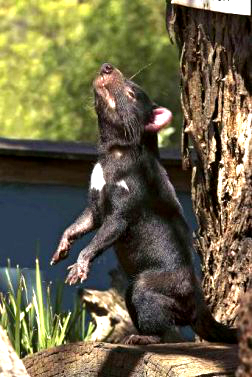Devil destruction gives clues on cancer evolution
 As Tasmanian Devil Facial Tumour Disease (DFTD) continues to ravage the world’s largest carnivorous marsupial, researchers say the treatment program is providing insights on influences for cancer evolution.
As Tasmanian Devil Facial Tumour Disease (DFTD) continues to ravage the world’s largest carnivorous marsupial, researchers say the treatment program is providing insights on influences for cancer evolution.
Facial tumours have been annihilating the Australian native since 1996, with populations shrinking to just ten per cent of their original numbers.
Conservation work to fight the disease has included removing infected individuals from the population, and new research says this gives a unique opportunity to understand how human selection alters the evolution of cancerous cells.
DFTD is an asexually reproducing clonal cell line, which has transformed as infected devils, approximately 33% of the population, have been removed from the Forestier Peninsula in Tasmania between 2006 and 2010.
However, this parasitical disease has been able survive and counteract the effect of harmful mutation and genomic instability, the condition has been able to infect more than 100,000 devils from the one site.
“In this study, we focus on the evolutionary response of DFTD to a disease suppression trial,” said Beata Ujvari, from the, The University of Sydney.
“Tumours collected from devils subjected to the removal programme showed accelerated temporal evolution of tetraploidy [having four chromosomes instead of two] compared with tumours from other populations,” Dr Ujvari said.
To explore the long-term effects of human selection on DFTD evolution, the team collected tumour tissue samples between 2006 and 2011 at 11 sites within the DFTD affected areas of Tasmania.
“Our study clearly demonstrates that DFTD tumours are able to rapidly respond to increased selection and adapt to a selective regime,” said Ujvari.
“The results suggest that ploidisation may offer yet another pathway to which DFTD is able to adapt to the ever-changing evolutionary landscape sculptured by the devils’ immune system.
“Our study is the first to show that anthropogenic selection may enhance cancer evolution in the wild, and it therefore cautions about what measures we employ to try to halt the spread of this devastating disease,” Dr Ujvari said.
More information is available in the full report, accessible here.








 Print
Print